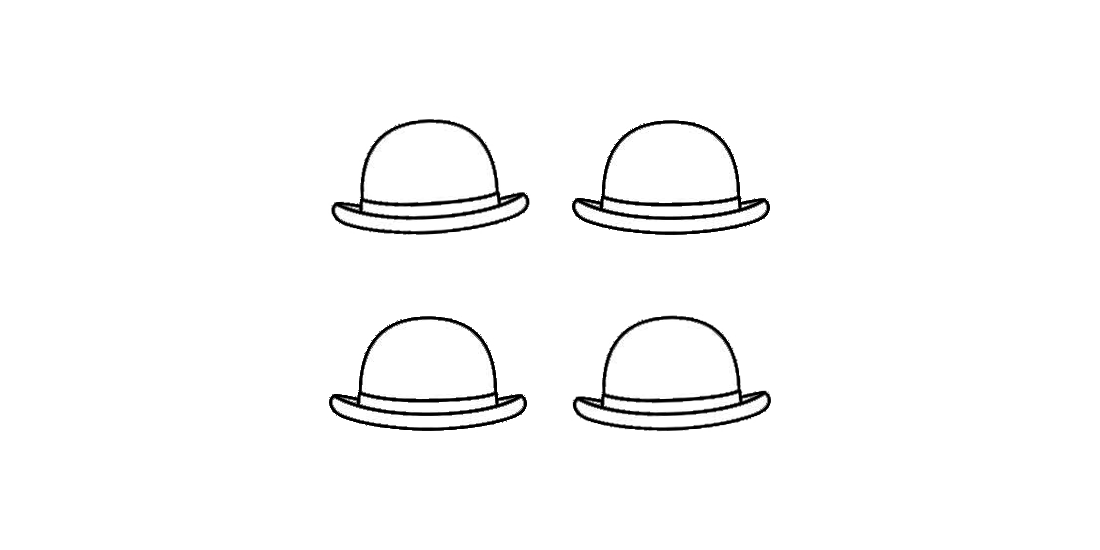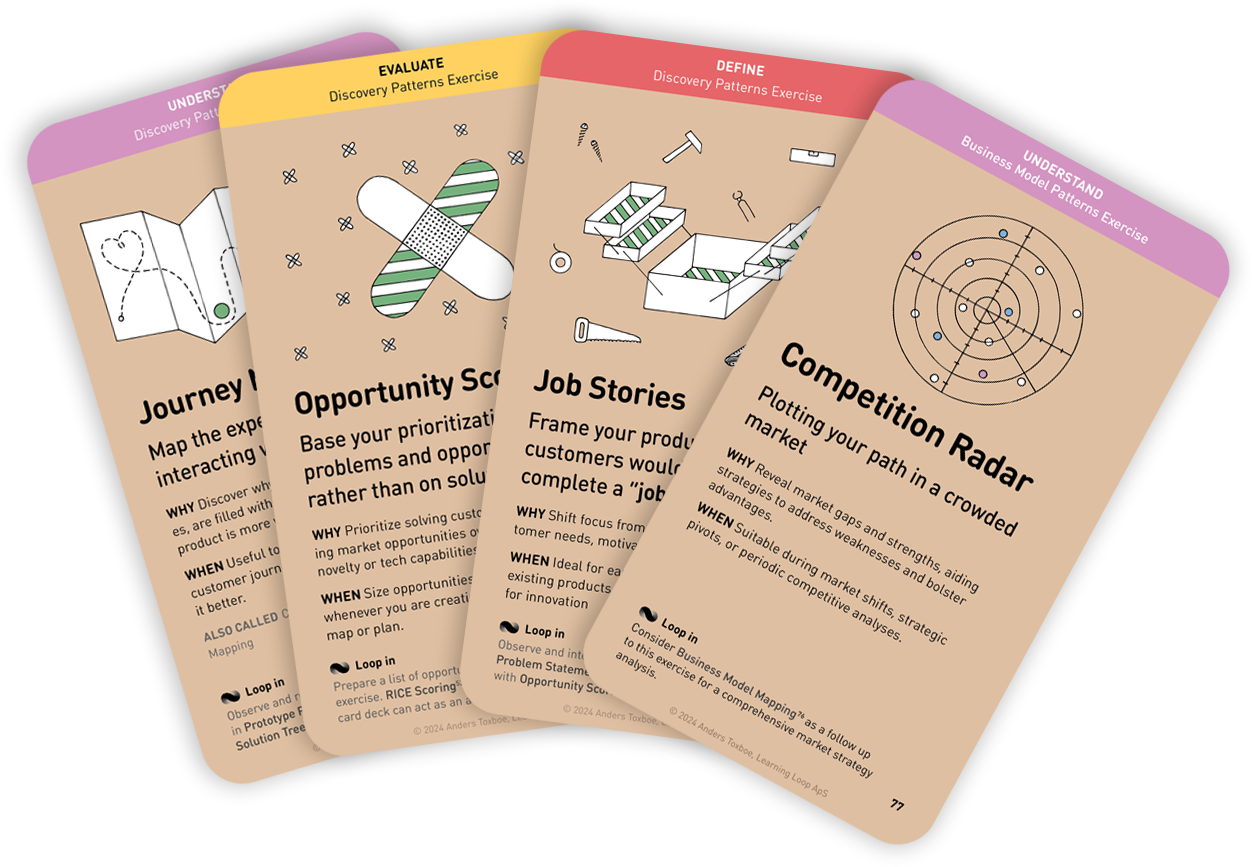Workshop Exercises: Understand
Thinking Hats
Force one of several perspectives upon a group to focus its discussions

Why: Promote balanced thinking, reduce conflict, and enable teams to decide on a holistic understanding of the situation
When: Use to get unstuck facing complex problems, conflicting opinions, or buried in the sme perspective
The core of the “Thinking Hats” exercise lies in deliberately compartmentalizing different modes of thinking to ensure that all relevant perspectives are explored when approaching a problem. The strategy is simple yet powerful: by isolating distinct aspects of cognition, participants are forced to think beyond their habitual cognitive patterns and consider diverse viewpoints, which enriches the overall decision-making or brainstorming process. The technique is designed to avoid groupthink, encourage critical thinking, and stimulate creative solutions by embracing structured, perspective-based thinking.
In most discussions, participants naturally default to familiar thinking styles, often shaped by personal experiences, professional backgrounds, or cognitive preferences. Some may focus on the risks and challenges, while others may be inclined to emphasize creative or optimistic perspectives. Without a structured approach, this dynamic can lead to lopsided conclusions, missed opportunities, or unaddressed risks.
Embracing a Thinking Hat is a deliberate strategy to break these habitual patterns. By forcing participants to wear a specific “hat” and adopt a predefined perspective, the exercise ensures that all angles of the problem are thoroughly examined. This artificial segmentation of thinking enables individuals to engage with the problem in ways they might not naturally do, leading to a more well-rounded understanding of the issue at hand.
Forcing Perspectives Through Hats
Each thinking hat in the exercise represents a distinct cognitive mode or perspective. These hats are designed to force participants into a specific mindset, encouraging them to examine the problem or solution through a new lens. This can be uncomfortable, as it often involves stepping outside one’s natural comfort zone, but it is precisely this discomfort that enables breakthroughs in thinking.
You can choose between many perspectives or even make up your own to force what you as a facilitator believe might constitute a fruitful perspective. Examples of Thinking hats could be:
-
Logic Hat. When a participant is wearing the Logic Hat, they are required to take a purely analytical approach. Their role is to focus on facts, data, and objective reasoning. The Logic Hat forces them to remove emotional and subjective biases, pushing them to validate ideas using evidence and measurable criteria. By segregating this thinking, the group can rigorously evaluate ideas based on reality rather than perception.
-
The Emotion Hat forces participants to embrace how feelings and emotional responses shape perspectives. While many may be inclined to suppress emotion in decision-making, this hat makes it explicit that feelings matter in understanding the broader human impact of a decision or idea. By focusing on emotional reactions, participants become more attuned to user sentiment, team morale, and the psychological implications of the issue.
-
The Creativity Hat pushes participants to discard conventional limits and think expansively. Here, the strategy is to actively seek out novel ideas, solutions, or approaches that might seem radical or unrealistic in other contexts. The Creativity Hat forces participants to venture into uncharted territory, encouraging innovation by temporarily suspending the practical or critical aspects of thinking.
-
Wearing the Risk Hat forces participants to look for what could go wrong. It is their responsibility to identify potential downsides, obstacles, and vulnerabilities. While some individuals naturally gravitate toward optimistic views, this hat ensures that the risks are explicitly discussed, providing a necessary balance to more hopeful or visionary thinking. This forced focus on risks helps prevent costly blind spots.
-
The Optimism Hat compels participants to find and emphasize the potential benefits and opportunities in a situation. By forcing a shift towards positivity, this hat ensures that even the most skeptical or risk-averse thinkers engage in envisioning success and identifying positive outcomes. This perspective opens the door to discovering advantages that might be overshadowed by caution or critical thinking.
-
The Perspective Hat forces participants to adopt the viewpoint of others, such as different stakeholders, clients, or other departments. By being required to consider how others might view the problem or solution, the group ensures a more empathetic and comprehensive exploration of the issue. This hat guarantees that solutions are not developed in isolation but instead reflect the concerns and needs of those affected by the outcome.
-
The Customer Hat is designed to place participants in the mindset of the end-user or customer, shifting the focus toward empathy and user-centered thinking. By forcing participants to consider how customers will experience, perceive, and respond to a product, service, or decision, this hat ensures that solutions are designed with the user in mind.
-
The Sustainability Hat forces participants to focus on the environmental, social, and long-term impact of their ideas. By adopting this perspective, participants evaluate how their decisions align with principles of sustainability and social responsibility.
-
The Collaboration Hat focuses on how individuals, teams, or organizations can work together effectively. This hat encourages participants to evaluate how the solution promotes teamwork, communication, and cooperation among stakeholders.
-
The Compliance Hat focuses on ensuring that the solution adheres to legal, regulatory, and ethical standards. By wearing this hat, participants are forced to examine the rules and guidelines that govern the implementation of their ideas.
Why force perspectives?
Each individual brings inherent biases to any discussion. The Thinking Hats exercise forces individuals to adopt perspectives they may not be naturally inclined toward, helping to counterbalance these biases. For instance, an individual who normally focuses on risks may be forced to focus on creative solutions, ensuring that their risk aversion doesn’t stifle innovation. Conversely, someone who tends to prioritize creativity and optimism will be required to confront potential pitfalls when wearing the Risk Hat.
By cycling through distinct perspectives, the group is forced to explore every aspect of an idea before reaching conclusions. This structured process prevents any one viewpoint from dominating the conversation. The result is a more thorough evaluation, where both the potential and the limitations of an idea are considered in a balanced manner.
This way of thinking taps into multiple cognitive processes—analytical, emotional, imaginative, and critical. This diversity of engagement ensures that all thinking styles are activated, leading to more robust problem-solving. For example, while some participants may naturally think analytically, the Creativity Hat forces them into a different mode of thinking, activating creative cognitive processes that might otherwise remain dormant.
Groupthink occurs when a group of people conform to a dominant viewpoint without critically evaluating alternative perspectives. The Thinking Hats exercise, by design, prevents this from happening. By explicitly requiring participants to adopt differing perspectives, it breaks up the conformity that can lead to poor decision-making and encourages a diversity of opinions.
The facilitator’s role in assigning hats
A crucial part of the exercise is the facilitator’s ability to select the appropriate hats based on the problem or goal of the session. In some cases, a more creative approach may be necessary, while in others, risks and data may take precedence. The facilitator must carefully choose which hats to include and in what sequence, ensuring the group addresses the problem from every angle. For instance, starting with the Optimism Hat may generate excitement and energy, while finishing with the Logic Hat allows the group to assess whether their creative ideas are viable.
By carefully orchestrating the use of different hats, the facilitator guides the group toward comprehensive and thoughtful conclusions. This flexibility ensures that the exercise can be tailored to fit different contexts, such as product development, risk management, or strategic planning.
Disney had a similar thought
Walt Disney’s Creative Strategy uses three roles—Dreamer, Realist, and Critic—to structure the process of developing and refining ideas. Each role forces participants to think in specific ways, similar to the Thinking Hats framework.
-
The Dreamer is all about expansive, visionary thinking. When embracing the Dreamer role, participants are encouraged to imagine the best possible outcome without considering limitations or constraints. The Dreamer forces the group to think creatively and boldly, asking: What would we do if there were no restrictions? What is the most ideal, fantastical version of this idea? This role fosters innovation, helping participants think outside the box and push the boundaries of what’s possible. It generates excitement and opens the door to groundbreaking ideas.
-
The Realist brings the Dreamer’s ideas down to earth. This role focuses on practicality, asking: How can we make this idea work in the real world? What steps are necessary to implement this solution? The Realist forces participants to plan and develop actionable steps to bring the Dreamer’s vision to life, considering resources, timelines, and constraints. The Realist ensures that grand ideas are translated into feasible actions, balancing creative ambition with pragmatic thinking. This role helps turn vision into reality.
-
The Critic takes a skeptical approach, challenging the assumptions of both the Dreamer and the Realist. This role asks: What are the weaknesses in this idea? What risks or obstacles could prevent this from succeeding? The Critic forces participants to examine potential flaws and identify areas for improvement, ensuring that the final idea is as robust as possible. The Critic plays a crucial role in stress-testing ideas, identifying risks, and ensuring that weaknesses are addressed before implementation.
The strategy behind Disney’s Creative Process is the deliberate separation of each role, ensuring that ideas are fully explored, planned, and critiqued. By embracing each role sequentially, participants are able to dream without limits, ground their vision in reality, and rigorously assess potential challenges. This structured approach allows for both creative freedom and critical evaluation, leading to well-rounded and viable solutions.
Instructions for running this play

In a large group setting (8+):
- The facilitator assigns different hats to each groups
- Set a Timebox of minimum 15 minutes to discuss the perspective in the group. Consider making it a Poster Session.
- Let each group do a Playback of their findings with a Timebox of 3-5 minutes.
- Let all participants Dot Vote on the best ideas
In a small group setting (3-8)
- The facilitator decides what hats to try sequentially.
- Step 2 from above
- Depending on the outcome of the first session, consider challenging the perspective with an opposing hat and repeat step 2.
- Let all participants Dot Vote on the best ideas
Tips to perfect this play
Master and adapt the play to fit your context and needs.
Tip: Everyone should use the same hat
To avoid personal preference and conflicts between modes of thinking, it is essential that all members in a group use the same hat at the same time.
Tip: Sequence matters, not quantity
You do not need to use all hats in a session. As a facilitator, consider what sequence of hats that best address different situations.
Tip: Rotate
Rotate the thinking roles among team members, allowing everyone to experience and contribute from different perspectives, fostering a shared understanding and empathy among the team.
A collection of workshop exercises that will help you ditch dull meetings and facilitate with confidence. It will help you master the design process and have more productive time with your team. The card deck will be ready for purchase in the end of 2026 and is now undergoing rigorous testing.
Reserve your deck!
